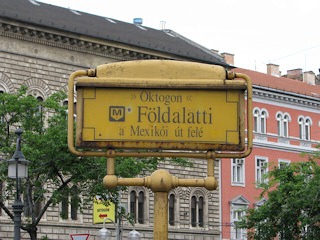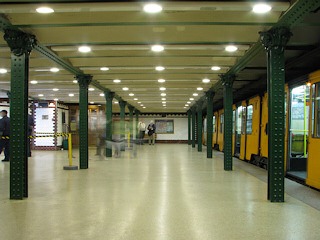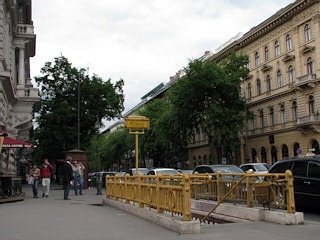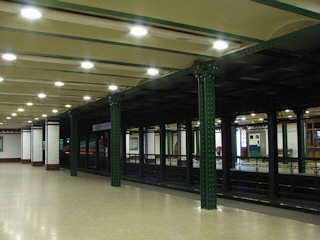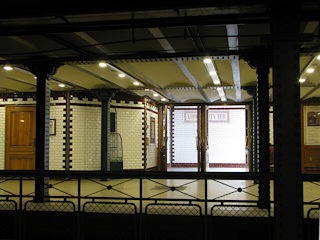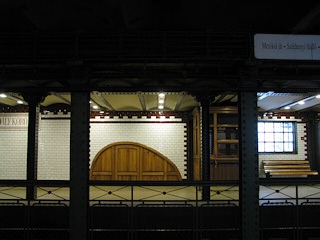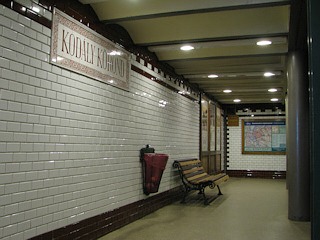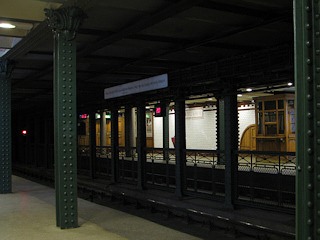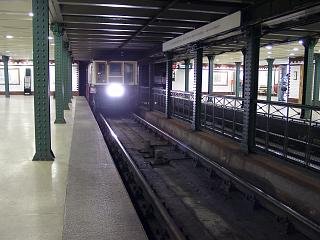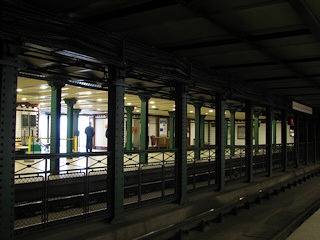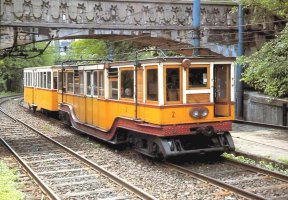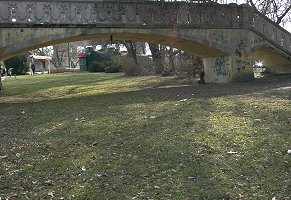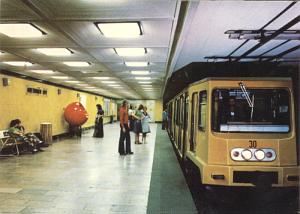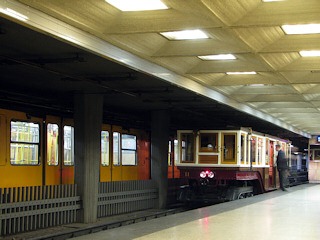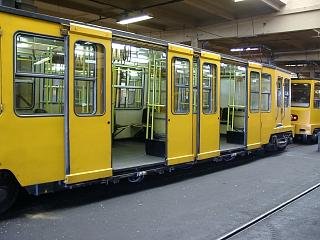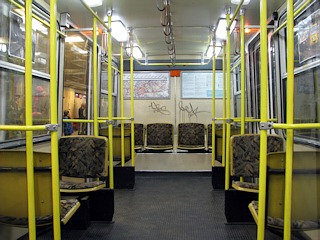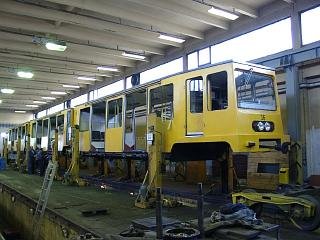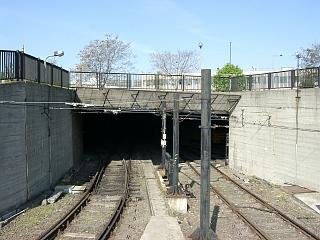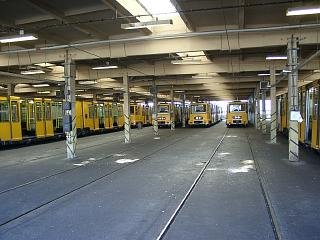budapest
other hungarian
close-up
lost rails
other countries
-
An introduction
to the "Kisföldalatti"
... with some trivia :)
Budapest's M1 metro line - called Földalatti (Subway), Kisföldalatti (Small Subway) or Milleniumi Földalatti Vasút (Milleneum Subway Line) in Hungarian and "Shallow Subway" in English - was built in 1895/96, with low-floor bogie cars using electric traction. It was the first underground railway in Continental Europe (the very first in all of Europe and the world was of course the Metropolitan Railway of London), and the first using electric motor cars (instead of locomotives, like the City&South London Railway). Now, I already wrote about this line before, but I thought it was time again to show a few photos and share a few bits of trivia about this historical gem!
The largest (most spacious) stop is the one at Oktogon. "Spacious" of course refers only to length and width of the platform, because the height is constrained: the line was build with a very low profile, so that it fits between the surface of the Grand Boulevard (Teréz körút) above and the large sewer tunnel beneath. They didn't want to dig a deep tunnel, because the soil is very soft around here, due to a branch of the Danube (Fossatum Magnum) once running just about where now the Grand Boulevard is.
Photo:
György Klösz, Source: WikiMedia Commons
On this photo you can clearly see the top of the sewer, which was truncated a bit to make room for the foundation of the tunnel. The Kisföldalatti had had to fit between that and the surface. The smaller tube to the right is a water mains, it's very likely that it was digged deeper.
In the fifties (between 1952 and 1956) the Bajcsy-Zsilinszky út station was the terminus while the first stage of the Deák Ferenc tér subway complex was built. A crossover switch was put between the tracks for the reversal of trains, and the missing pillars where the crossover was located, were supplemented with stronger pillars on the platforms - these are the thick, tiled ones at the end of the platforms. Since then the middle pillars were retrofitted, but just for the looks, they don't really hold the ceiling.
The tunnel of the Kisföldalatti was built with the cut-and-cover method, so it has a box-shape cross-section, with the wall very close to the trains. The less important stops like the one at Kodály körönd, Bajza utca or Vörösmarty utca are also quite small.
Photo:
György Klösz. Source: WikiMedia Commons
A cross-section of the running tunnel can be seen on this old photo.
At the smaller stations you can see some simple, tube-like pillars instead of the riveted ones. They are there because these small stops were enlarged in the 1960s to house longer trains, and these extensions used such pillars to hold the ceiling. These enlargements were done without disruption of the traffic.
Now let's ride the line with a heritage vehicle, to see what it muat have been like when it was opened!
Two more pictures of the old stops.
The ramp once leading to the surface in Városliget, featured in the deliberately old-fashioned movie "Régi idők focija" ("Soccer of Old Times"), debuted in 1973.
New stops and the remnants of the old alignment
The line was modernised and extended in 1973/74, to celebrate the 100th anniversary of Buda, Pest and Óbuda merging into Budapest. Among many other things, they also changed from left-hand to right-hand running.
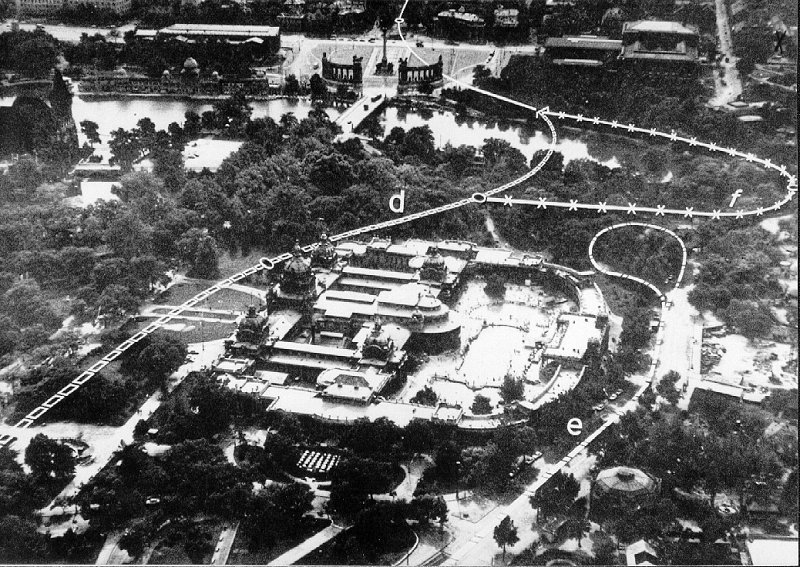
Source: the collection of
Zoltán Ádám Németh
The old section and the terminus in Városliget (City Park) was located on the surface (marked with crossed-out line on the photo), circling a lake, while the new alignment ran straight underneath (dashed line). Széchenyi fürdő (Széchenyi Thermal Bath) and the Mexikói út terminus are the two new stops built at that time - the old terminus Széchenyi fürdő and the stop Állatkert (Zoo) was abandoned and torn down.
Near the northern corner of Hősök tere, you can make out where the old and new alignment diverges: the ramp from the tunnel to the surface took a slight left turn and ran under that strangely shallow bridge in the background, while the current alignment remains underneath, making a "bump" inside - and thus dividing - the lake (which can be observed on this photo because the water was drained from the right-hand-side half of the lake for construction works).
That strange bridge used to be a flyover over the tracks, which was needed because it wasn't allowed to cross the tracks in level due to the low overhead wires. This flyover was one of the first ferroconcrete bridges in the country, therefore its now a scheduled monument. Fortunately it was renovated and repainted since I took the photo on the right :) As for other remnants, it's quite unbelievable, but true: the original depot hall is still there in Dózsa György út, used as a garage!
At the construction of the new stretch, they didn't attempt to build old-looking stops, instead they chose the modern look of the time. On the left you can see the stop Széchenyi fürdő in its original form (source: collection of NZA), and Mexikói út today - both stops were slightly altered during the 1996 overhaul of the line.
Before we continue, here's a video of all what we discussed and seen until now :)
The line is operated with 23 double-articulated units built by Ganz-MÁVAG and Ganz Villamossági Művek in the 1970s and 80s. The first two vehicles were built in 1971, and were first tested on the original form of the line:
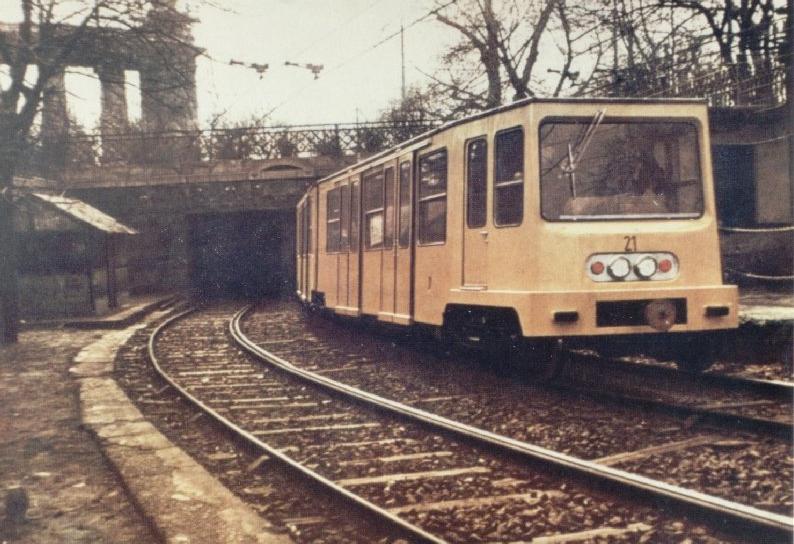
Source: the collection of
Zoltán Ádám Németh
Number 21-41 were introduced to active stock by 1973, but the last two cars, number 42 and 43 were built in 1987, when the available rolling stock proved to be insufficient for the growing demand.
Since the constraints of height remained, but larger capacity was required, a three-part vehicle was designed with the articulation tunnels hiding most of the technical equipment.
Many parts of the Ganz CSMG2 articulated tram were used, but a big difference was the usage of a pneumatic brake system. The result is a low-floor tram, which was even tested in passenger traffic as such, on tram line 62! Of course using a large pantograph, because the own current collector of the vehicle does not reach up to the height of the tram overhead wire.
Only the two inner (Jacobs) bogies are powered - such a bogie can bee seen to the left, with the pivot in the middle.
Some technical specs:
Length: 30.370/29.560 mm
Width: 2.200 mm
Height: 2.590 mm
Floor height: 470 mm
Passengers: 48 seats + 113 standing
Motors: 4 x GVM TK44A (a 66 kW)
Maximal speed: 60 km/h
In it's current form, the whole line is underground, and only the depot is located conveniently on the surface at Mexikói út. There is a connecting track to the tram network, which is used when a vehicle is transported to the Fehér út workshop.
As a conclusion of this page, here's a video of heritage car number 11 moving inside the depot. Unfortunately this is a very rare sight, they tend to guard this vehicle locked away.
Back to the top Back to the main page
